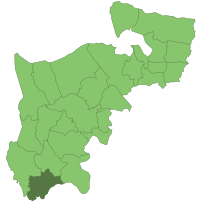Sunbury-on-Thames Urban District facts for kids
| Sunbury on Thames | |
| Motto: Sol et Pastor Deus (God is my Sun and Shepherd) | |
 Sunbury-on-Thames 1965-1974 |
|
| Geography | |
| Status | Urban district |
| 1894 area | 2,659 acres (10.8 km2) |
| 1974 area | 5,609 acres (22.7 km2) |
| HQ | Poor Law institute and at the Assembly Rooms (during 1895) from 1895: Church Villa from 1930: Benwell House Sunbury-on-Thames |
| History | |
| Created | 1894 |
| Abolished | 1974 |
| Succeeded by | Spelthorne |
Quick facts for kids Demography |
|
|---|---|
| 1901 population | 4,544 |
| 1971 population | 40,179 |
The Sunbury on Thames Urban District was a special local government area in England. It existed from 1894 until 1974. Its main job was to manage local services for the people living in Sunbury-on-Thames.
At first, it only covered the town and parish of Sunbury. Later, in 1930, it grew to include the areas of Littleton and Shepperton. Think of it like a local council that looked after things like roads, lighting, and health for its community.
Contents
What Was the Sunbury Urban District?
In 1894, a new law called the Local Government Act 1894 created many "urban districts" across Britain. Sunbury on Thames became one of these. It was part of the larger administrative county of Middlesex.
This new district was given important jobs. It was responsible for planning, street lighting, and keeping the area clean and healthy. For 36 years, it only covered the Sunbury parish. This parish included smaller areas like Charlton and Upper Halliford.
In 1930, the Sunbury Urban District became bigger. It took over the parishes of Shepperton and Littleton. This happened when another local government area, the Staines Rural District, was closed down.

How the Council Worked
Before the urban district was formed, local matters were handled by the "vestry." This was like an early local council, often linked to the church. For example, by 1795, Sunbury had a fire engine. Local officials like the "beadle" and "overseer" looked after it.
People in Sunbury wanted better services. In 1890, there was a big push for improved drainage systems. By 1892, residents decided they needed a proper urban district. They felt the older system wasn't doing enough.
Early Days of the Council
The new urban district council started in 1894. Its first meeting was in January 1895. The council had 12 members at first. These members were like local politicians, making decisions for the area.
They met at the Assembly Rooms on Thames Street. Later in 1895, they moved to Church Villa. By 1930, this building was too small. The council then bought a house called Benwell, which became their main office.
Council's Responsibilities
The council took on many tasks. In 1895, they hired people for important roles. These included a surveyor (who planned building projects) and an inspector of nuisances (who dealt with public health issues).
They also had committees to focus on different areas. These included finance, roads, lighting, and the fire brigade. A major early project was setting up a proper sewerage system. By 1900, a new cemetery was also opened.
Over the years, the council built many homes. By 1957, they had built 1,570 houses and flats. Most of these were in the original Sunbury parish area.
The District's Coat of Arms
The Sunbury on Thames Urban District was given its own special coat of arms in November 1948. A coat of arms is a unique design that represents a place or family.
The design had symbols that told a story about the area. It featured two shepherd's crooks, which stood for Shepperton. A mitre, a special hat worn by bishops, represented Sunbury-on-Thames.
The district's motto was in Latin: "Sol et Pastor Deus." This means "God is my sun and shepherd." This motto was a clever play on words, combining "Sun" from Sunbury and "Sheppert" from Shepperton.
What Happened Next?
In the 1960s, there were big changes to local government in England. A group called the Royal Commission on Local Government in Greater London suggested changes for the London area.
Most of Middlesex county became part of Greater London in 1965. However, Sunbury on Thames Urban District did not join London. Instead, it moved to a neighboring county, Surrey.
Finally, in 1974, the Sunbury Urban District was officially closed down. This happened because of another new law, the Local Government Act 1972. Its area was then combined with the Staines Urban District. Together, they formed a new local government area called the Borough of Spelthorne, which still exists today.
See also
- Local Government Act 1894
- London Government Act 1963
- Local Government Act 1972
- Middlesex County Council
- Surrey County Council
- Sanitary Districts

